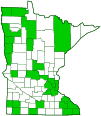cereal rye
(Secale cereale)
Conservation • Weed • Description • Habitat • Ecology • Use • Distribution • Taxonomy
Description |
||
Cereal rye is an annual, exotic, tuft-forming grass. The stem (culm) is slender, erect, hollow between the nodes, branched from the base, leafy, and 20″ to 48″ in height, over-topping the leaves. The culm surface is bluish-green and covered with a whitish, waxy film (glaucous). It is usually hairless, sometimes hairy below the spike. The lower part of the leaf that surrounds the stem (sheath) is usually shorter than the distance between the nodes. It is open, not fused together most of the way to the top. The sheath on the lowermost leaf may be hairy, but those of the other leaves are hairless. The appendage at the inner (upper) surface at the tip of the leaf sheath (ligule) is 1 ⁄32″ (1 mm) long. It is thin, pliable, more or less transparent (membranous), and straight across (truncate) at the top but often irregularly cut and appearing torn (lacerate). The leaf blade is flat, grass-like (linear), parallel-veined, usually hairless, up to 11¾″ long, and ⅛″ to ½″ wide. There are often small projections (auricles) at the base. The inflorescence is a single dense spike at the end of the stem. The spike is slender, linear-oblong in outline, somewhat flattened, and 2″ to 6″ long not counting the bristle-like tips (awns). It is somewhat nodding at maturity. The spike is composed of numerous, crowded, alternate, spikelets, a solitary spikelet at each node of the inflorescence. They are positioned with a flat side against the axis (rachis). The spikelets are all similar in appearance and size. At the base of each spikelet there are two sterile bracts (glumes), the first one the lower, the second one the upper. There are usually two florets on a short axis (rachilla). When there is a third, the third is undeveloped (rudimentary) and above the others. The florets consist of an outer bract (lemma), an inner bract (palea), and 2 fleshy scales (lodicules) at the base of the stamens or pistil. The male floret has 3 yellow, ¼″ to 5 ⁄16″ long stamens. The female floret has 1 pistil with 2 styles. The upper and lower glumes are similar in size in shape, narrowly linear, sharply pointed, ¼″ to ½″ (6 to 13 mm) long, and 1 ⁄64″ to 1 ⁄32″ (0.5 to 1.0 mm) wide. They have 1 nerve and a raised ridge (keel). They are hairless but the keel is rough. The lemma is thickened, somewhat hard, 7 ⁄16″ to ⅝″ (11 to 16 mm) long, and elliptic egg-shaped. It has 5 nerves and a keel that is off-center. The keel continues as a bristle-like extension (awn) that is up to 2¾″ long. The lemma is hairless except for a line of stiff hairs on the keel and on the margins. The palea is shorter than the lemma. At maturity, the spikelet breaks off (disarticulates) above the glume and between the florets. The fruit is an oblong, ¼″ to ⅜″ long, specialized capsule (caryopsis) in which the ovary wall is fused to the seed coat. It is yellowish-brown to orangish-brown, deeply grooved, and hairy at the tip. |
||
Height |
||
20″ to 48″ |
||
Similar Species |
||
Habitat |
||
Roadsides, old fields, and other disturbed areas |
||
Ecology |
||
Flowering |
||
July to August |
||
Pests and Diseases |
||
|
||
Use |
||
Cereal rye is widely cultivated as a food crop.. It is often seeded in road banks following construction as a cover crop to prevent soil erosion. |
||
Distribution |
||||
|
Sources |
|||
| 3/23/2023 | ||||
Nativity |
||||
Native to Europe, Asia, and the Indian subcontinent. Widely cultivated. Often escapes but rarely persists. |
||||
Occurrence |
||||
|
||||
Taxonomy |
|||
| Kingdom | Plantae (Plants) | ||
| Subkingdom | Pteridobiotina | ||
| Phylum | Tracheophyta (Vascular Plants) | ||
| Class | Liliopsida (Monocots) | ||
Order |
Poales (grasses, sedges, cattails, and allies) | ||
Family |
Poaceae (grasses) | ||
| No Rank | BOP clade | ||
| Subfamily | Pooideae | ||
| Supertribe | Triticodae | ||
| Tribe | Triticeae | ||
| Subtribe | Hordeinae | ||
Genus |
Secale (rye) | ||
Synonyms |
|||
Secale turkestanicum Triticum cereale |
|||
Common Names |
|||
cereal rye common rye cultivated annual rye cultivated rye rye |
|||
Glossary
Auricle
A small, ear-like projection at the base of a leaf or at the junction of a grass blade and stem.
Awn
A stiff, bristle-like appendage at the tip of the glume, lemma, or palea of grass florets.
Bract
Modified leaf at the base of a flower stalk, flower cluster, or inflorescence.
Culm
The hollow or pithy stem of a grass, sedge, or rush.
Glaucous
Pale green or bluish gray due to a whitish, powdery or waxy film, as on a plum or a grape.
Glume
A chaffy, empty, sterile bract at the base of a grass spikelet. Glumes usually occur in pairs, but occasionally only one is present.
Ligule
In grasses, a membranous appendage at the junction of the leaf and the leaf sheath, sometimes no more than a fringe of hairs. In flowering plants, the flat, strap-shaped, petal-like portion of the corolla of a ray floret.
Membranous
Thin, pliable, and more or less transparent.
Node
The small swelling of the stem from which one or more leaves, branches, or buds originate.
Rachis
The main axis of a compound leaf, appearing as an extension of the leaf stalk; the main axis of an inflorescence.
Sheath
The lower part of the leaf that surrounds the stem.
Spikelet
In flowering plants, a small spike. In grasses and sedges, the basic unit of inflorescence. In grasses, composed of usually two glumes and one or more florets. In sedges, a single flower and its single associated scale.
Visitor Photos |
|||||
Share your photo of this plant. |
|||||
| This button not working for you? Simply email us at info@MinnesotaSeasons.com. Attach one or more photos and, if you like, a caption. |
|||||
|
|||||
MinnesotaSeasons.com Photos |
|||||
Plants |
|||||
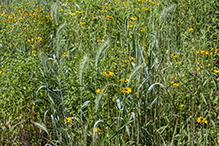 |
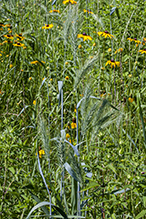 |
||||
Inflorescence |
|||||
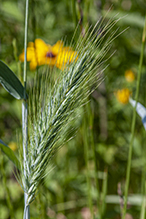 |
|||||
Leaves |
|||||
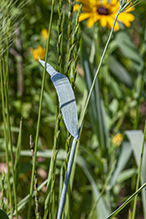 |
|||||

Slideshows |
||

Visitor Videos |
|||
Share your video of this plant. |
|||
| This button not working for you? Simply email us at info@MinnesotaSeasons.com. Attach a video, a YouTube link, or a cloud storage link. |
|||
Other Videos |
|||

Visitor Sightings |
|||||
Report a sighting of this plant. |
|||||
| This button not working for you? Simply email us at info@MinnesotaSeasons.com. Be sure to include a location. |
|||||
|
|||||
MinnesotaSeasons.com Sightings |
|||||

Created: 7/4/2019
Last Updated:
